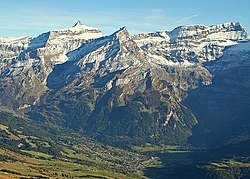| Bernese Alps in the wide meaning | |
|---|---|
| German: Berner Alpen i.w.S. French: Alpes Bernoises d.l.s.l. | |
 Aerial view on the Finsteraarhorn (4275m) | |
| Highest point | |
| Peak | Finsteraarhorn [1] |
| Elevation | 4,274 m (14,022 ft) |
| Coordinates | 46°21′15″N8°07′34″E / 46.35417°N 8.12611°E |
| Geography | |
| Country | Switzerland |
| Cantons | Bern, Vaud, Valais, Lucerne, Uri, Nidwalden and Obwalden |
| Parent range | Alps |
| Borders on | Lepontine Alps, Pennine Alps, Graian Alps, Savoy Prealps, Swiss Prealps and Glarus Alps i.t.w.m. |
| Geology | |
| Orogeny | Alpine orogeny |
The Bernese Alps in the wide meaning (in German Berner Alpen i.w.S., [2] in French Alpes Bernoises D.l.s.l. [3] ) are a mountain range in the northwestern part of the Alps. They are located in Switzerland.




